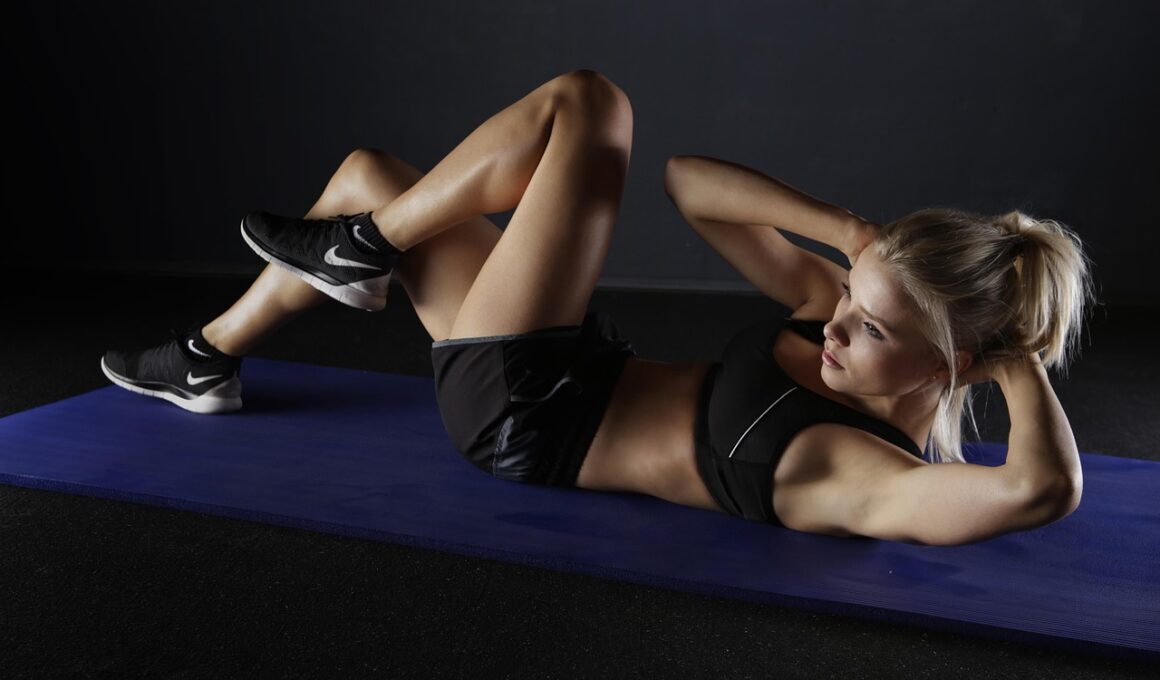Top Core Circuit Moves to Try This Week
Core strengthening exercises are essential for building stability, improving posture, and enhancing athletic performance. This week we will explore various core circuit moves that can be easily implemented into your workout routine. These exercises are designed to engage your entire core, which includes your abdominals, obliques, and lower back. Not only will these moves help tone your midsection, but they will also boost your endurance and overall fitness levels. Incorporating high-intensity interval training (HIIT) into your core circuit routine can increase calorie burn and speed up results. You can perform these moves with little to no equipment, making them accessible for everyone, regardless of gym availability. Each exercise focuses on different muscles, ensuring a comprehensive workout. Remember, consistency is key when it comes to seeing results. Set aside time each week to commit to these circuits. Before starting any new exercise regimen, consider consulting with a professional trainer or a fitness expert. Now, let’s dive into some of the best core circuit moves you can start doing today!
Plank Variations
The plank is one of the most effective exercises for core strengthening, and many variations exist to target different muscle groups. Begin with the traditional forearm plank, ensuring your body is in a straight line from head to heels. Progress into side planks to target the obliques, or try plank jacks for a more dynamic version that incorporates cardiovascular elements. Another effective variation is the shoulder tap plank, where you touch your shoulders with alternating hands without letting your hips sway. Additionally, introducing stability equipment like a Swiss ball can enhance your workout. Place your feet on the ball while maintaining the plank position to increase difficulty. Remember to engage your core throughout each variation and avoid letting your hips drop. For a more significant challenge, hold each plank position for extended periods, increasing the time as you build strength. Aim to include these plank variations into your circuit routine several times per week for optimum results. Incorporating different angles and equipment into your planks will keep workouts fresh and invigorating. Consistency will lead to noticeable improvements over time.
Russian twists are a fantastic exercise to enhance your rotational core strength. This dynamic move helps to balance out your muscles by engaging the obliques as you twist from side to side. To perform a Russian twist, start by sitting on the floor with your knees bent and your feet flat. Lean back at a 45-degree angle, keeping your back straight. Clasp your hands together or hold a weight in front of you for added resistance. While maintaining your balance, twist your torso to the right, bringing your hands or weight toward the floor beside you. Then twist to the left and repeat the prescribed number of repetitions. Consider keeping your feet elevated off the ground for an additional challenge, which activates your core even more. You can perform Russian twists as part of a circuit routine alongside planks or mountain climbers. This will ensure a comprehensive engagement of various core muscles. Remember to exhale during the pivot and stay controlled throughout the movement for effectiveness. Consistent practice will help develop your core strength and improve overall stability during other exercises.
Mountain Climbers
Mountain climbers are another excellent exercise that blends cardio with core strengthening. To execute this dynamic move, begin in a standard push-up position with your hands shoulder-width apart. From this position, bring your right knee toward your chest, then quickly switch to bring your left knee forward. The key to a successful mountain climber is maintaining a steady pace while focusing on form. Keep your core tight and your back flat as you continue to alternate legs. This exercise can quickly raise your heart rate while also engaging multiple muscles, including adductors and hip flexors. For added intensity, try performing mountain climbers on an unstable surface, such as a BOSU ball or balance board. This will further challenge your stability and engage even more core muscles. Incorporate mountain climbers into your HIIT sessions to maximize calorie burn and strengthen your midsection simultaneously. Aim for intervals of 30 seconds with short rest periods, repeating for multiple sets. This exercise is ideal for those looking to enhance their endurance and core strength without much equipment.
Leg raises are a classic core exercise that focuses on the lower abdominal muscles. Start by lying flat on your back with your legs extended and your arms by your side or under your hips for support. Slowly lift your legs off the ground, keeping them together and straight, until they form a 90-degree angle with your body. Lower your legs back down without letting them touch the ground for added intensity. Ensure that your lower back stays flat on the floor throughout the movement to prevent injury. For beginners, bent knee leg raises can be performed until core strength improves. This is a great way to lessen the intensity while still targeting the lower abs. Leg raises can be integrated into your circuit with other exercises, such as planks and Russian twists, for a balanced core training session. Aim for 10-15 repetitions, allowing for 2-3 sets with short breaks for maximum efficiency. This exercise is particularly effective for developing foundational core strength while also contributing to visible muscle definition when performed consistently.
Bicycle Crunches
Bicycle crunches are a compound exercise that effectively engages both the upper and lower abdominal muscles while also targeting your obliques. Start by lying flat on your back with your hands placed lightly behind your head. Bring your legs up, bending your knees at a 90-degree angle. As you lift your shoulder blades off the ground, extend one leg while twisting your torso to bring your opposite elbow toward the bent knee. Alternate sides in a controlled manner, simulating a pedaling motion. It’s important to focus on using your core to control the movement rather than pulling with your neck or arms. Perform bicycle crunches at a tempo that allows you to maintain form while engaging in high-volume circuits. Aim for 15-20 repetitions per side, ensuring each twist fully engages the oblique muscles. This exercise can easily be paired with other core moves for a complete session. Through consistent practice, you will notice improvements in your core strength and stability, providing a solid foundation for other more advanced workouts and daily activities.
Incorporating a variety of core circuit moves into your routine can be both enjoyable and beneficial. Beyond just looking great, a strong core improves functional movements, providing support for lifting and maintaining balance. Not only does core training provide physical strength, but it can also lead to increased confidence in your physical abilities. Remember that achieving your fitness goals takes time and continuous effort. Listen to your body’s signals and adjust your circuit routines as necessary, incorporating adequate recovery time. Recovery is essential for muscle repair and growth, allowing you to push harder during your next workout. Consider mixing these exercises into your weekly schedule at least 3-4 times, ensuring you challenge yourself with new variations along the way. Also, don’t forget the importance of proper hydration and nutrition as you work toward your goals. Aim for a balanced diet rich in proteins and healthy fats to fuel your workouts. Keep track of your progress to stay motivated, as small improvements can lead to significant results over time. Embrace the journey of strength building and enjoy the process of getting fitter.
Circuit Structure and Progression
Establishing a proper structure for your core circuit workouts is vital for maximizing effectiveness and results. A good core circuit usually consists of a combination of static and dynamic moves targeting various parts of the core. One way to set up your workouts is by alternating between these two types of exercises. For instance, you can start with static holds like planks, followed by dynamic exercises such as mountain climbers. Each circuit can include 5-6 different exercises performed for a set time, usually 30-45 seconds each, followed by a brief rest period. Consider performing 3-4 rounds of these circuits, ensuring an adequate rest between each round to maintain intensity. Progressions can also be incorporated by increasing time, repetitions, or decreasing rest periods as you build strength. Additionally, it is beneficial to switch up exercises every few weeks, making sure to challenge your muscles in new ways. Tracking your workouts and progress is crucial to adjusting your routine according to your growing strength levels. Finding a circuit structure that keeps you motivated will ultimately lead to better adherence to your fitness journey.


